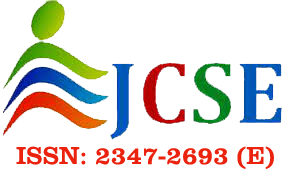Pattern Recognition of Iris flower using Neural Network based Particle Swarm Optimization
D. T. Mane1 , U. V. Kulkarni2
- Department of Computer Engineering, Pune Institute of Computer Technology, Pune, India.
- Department of Computer Science and Engineering, S. G. G. S. I. E. & T., Nanded, India.
Section:Research Paper, Product Type: Journal Paper
Volume-6 ,
Issue-5 , Page no. 916-920, May-2018
CrossRef-DOI: https://doi.org/10.26438/ijcse/v6i5.916920
Online published on May 31, 2018
Copyright © D. T. Mane, U. V. Kulkarni . This is an open access article distributed under the Creative Commons Attribution License, which permits unrestricted use, distribution, and reproduction in any medium, provided the original work is properly cited.
View this paper at Google Scholar | DPI Digital Library
How to Cite this Paper
- IEEE Citation
- MLA Citation
- APA Citation
- BibTex Citation
- RIS Citation
IEEE Style Citation: D. T. Mane, U. V. Kulkarni, “Pattern Recognition of Iris flower using Neural Network based Particle Swarm Optimization,” International Journal of Computer Sciences and Engineering, Vol.6, Issue.5, pp.916-920, 2018.
MLA Style Citation: D. T. Mane, U. V. Kulkarni "Pattern Recognition of Iris flower using Neural Network based Particle Swarm Optimization." International Journal of Computer Sciences and Engineering 6.5 (2018): 916-920.
APA Style Citation: D. T. Mane, U. V. Kulkarni, (2018). Pattern Recognition of Iris flower using Neural Network based Particle Swarm Optimization. International Journal of Computer Sciences and Engineering, 6(5), 916-920.
BibTex Style Citation:
@article{Mane_2018,
author = {D. T. Mane, U. V. Kulkarni},
title = {Pattern Recognition of Iris flower using Neural Network based Particle Swarm Optimization},
journal = {International Journal of Computer Sciences and Engineering},
issue_date = {5 2018},
volume = {6},
Issue = {5},
month = {5},
year = {2018},
issn = {2347-2693},
pages = {916-920},
url = {https://www.ijcseonline.org/full_paper_view.php?paper_id=2087},
doi = {https://doi.org/10.26438/ijcse/v6i5.916920}
publisher = {IJCSE, Indore, INDIA},
}
RIS Style Citation:
TY - JOUR
DO = {https://doi.org/10.26438/ijcse/v6i5.916920}
UR - https://www.ijcseonline.org/full_paper_view.php?paper_id=2087
TI - Pattern Recognition of Iris flower using Neural Network based Particle Swarm Optimization
T2 - International Journal of Computer Sciences and Engineering
AU - D. T. Mane, U. V. Kulkarni
PY - 2018
DA - 2018/05/31
PB - IJCSE, Indore, INDIA
SP - 916-920
IS - 5
VL - 6
SN - 2347-2693
ER -
| |
|
|
| 666 | 320 downloads | 189 downloads |
Abstract
In machine learning, classification is a technique to identify the category to which an observation belongs, based on a labeled training data. It is a task of approximating a mapping function from input variables to discrete output variables. Pattern classification delivers this approximation by automatically discovering the regularities in the data using learning algorithms. It is an important sub-topic of machine learning with interesting applications like speech recognition and classification of rocks. In this paper, propose a hybrid approach Artificial Neural Network with Particle Swarm Optimization (ANNPSO) algorithm for pattern recognition. The ANNPSO works under the two main principles, first the error is calculated by using artificial neural network and second, error is optimized using Particle swarm optimization algorithms. Model tested on well known standard pattern IRIS flower dataset. Performance of presented model is evaluated with five-fold cross validation which produces 99.33% testing accuracy. Experimental results are superior than the existing ones. Therefore, ANNPSO provides better testing results in Iris pattern classification problems.
Key-Words / Index Term
Artificial Neural Network, Pattern Classification, Particle Swarm Optimization
References
[1] Kennedy James and Eberhart, Russell, “Particle swarm Optimizat-
ion”, in Proceedings of IEEE International Conference on Neural Networks, Volume 4,pp. 1942 -1948, 1995.
[2] R. A. Fisher, “The use of multiple measurements in taxonomic problems”, Annals of Eugenics, Volume 7 (2), pp.179-188, 1936.
[3] V. Borovinskiy, “Classification of Iris data set”, University of Ljubljana, Ljubljana, 2009.
[4] H. Chang and A. Astolfi, “Gaussian Based classification with application of the iris dataset”, In Proceedings of the 18th World Congress The International Federation of Automatic Control Milano (Italy) August 28 - September 2, 2011.
[5] V. Kumar and N. Rathee, “Knowledge discovery from database Using an integration of clustering and classification”, International Journal of Advanced Computer Science and Application, Volume 2, No.3,pp. 29-33, 2011.
[6] D. Dutta, A. Roy and K. Choudhury, “Trainning Aritificial Neural Network using Particle swarm Optimization Algorithms”, IJARCSSE , volume 3, Issue 3, pp. 430-434, 2013.
[7] S. Vyas 1 and D. Upadhyay, “Identification of Iris Plant Using Feed Forward Neural Network On The Basis Of Floral Dimensions”, IJIRSET, Volume 3, Issue 12, pp. 18200 - 18204 2014.
[8] Shashidhar T. Halakatti and Shambulinga T. Halakatti, “Identification Of Iris Flower Species Using Machine Learning”, International Journal of Computer Science, Volume 5, Issue 8, pp. 59-69, 2017.
[9] K. H. Wandra1 and L.P. Gagnani, “Classification Techniques in WEKA: A Review”, International Journal of Computer Sciences and Engineering,Volume 5, Issue 8, pp. 49-52, 2017.
[10] Mohan P.M, Paul N. K, Prakash M., Praveen K. D and Chidambaram S, “Comparative Evaluation of Various Techniques for Fisher’s Iris Classification”, International Journal of Innovative Research in Science, Engineering and Technology, Volume 7, Issue 1, pp. 198-202, 2018.
[11] D. E. Rumelhart, G. E. Hinton, and R. J. Williams, “Learning internal representations by error propagation”, in Parallel Distributed Processing: Explorations in the Microstructure of Cognition, Vol. 1, D. E. Rumelhart, J. L. McClelland, and PDP Research Group, Eds., pp. 318–362, MIT Press, Cambridge, Mass, USA, 1986.
[12] R C, Eberhart and Kennedy, James, “A New Optimizer Using Particle Swarm Theory”, MHS`95. Proc. Sixth Int. Symp. Micro Mach. Hum. Sci., pp.39 - 43, 1995.
